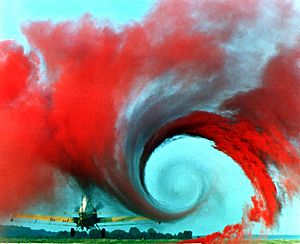Vortex facts for kids
A vortex is a spinning, often swirling, flow of liquid or gas. Imagine water going down a drain or wind forming a tornado. That spinning motion is a vortex! The fluid spins very fast at the center of the vortex. As you move further away from the center, the spinning speed gets slower.
Contents
What is a Vortex?
A vortex happens when a fluid, like water or air, moves in a circle around a central point. Think of a tiny whirlpool in your bathtub or a giant tornado in the sky. Both are examples of vortices. The word "vortex" comes from a Latin word meaning "to turn" or "to whirl."
How Do Vortices Form?
Vortices form when a fluid starts to rotate. This can happen in many ways. For example, when water drains from a sink, it starts to spin because of the shape of the drain and how the water is moving. Air can also form vortices when it moves over obstacles, like mountains, or when different air masses meet.
Where Can We See Vortices?
Vortices are all around us! You can see them in your everyday life and in nature.
- Water draining: The most common example is the swirl of water going down a drain.
- Tornadoes and hurricanes: These powerful storms are huge vortices of air.
- Smoke rings: When you blow a smoke ring, you are creating a small vortex.
- Airplane wings: As an airplane flies, its wings create vortices at their tips. These are called wingtip vortices.
- Rivers and oceans: You can see small whirlpools in rivers or larger eddies in the ocean.
- Space: Even planets like Saturn have giant vortices in their atmosphere, like the one at its north pole.
Why Are Vortices Important?
Vortices are important in many areas of science and engineering.
- They affect how airplanes fly.
- They influence weather patterns and ocean currents.
- Scientists study vortices to understand how fluids move. This helps them design better ships, planes, and even predict weather.
Images for kids
See also
 In Spanish: Vórtice para niños
In Spanish: Vórtice para niños











